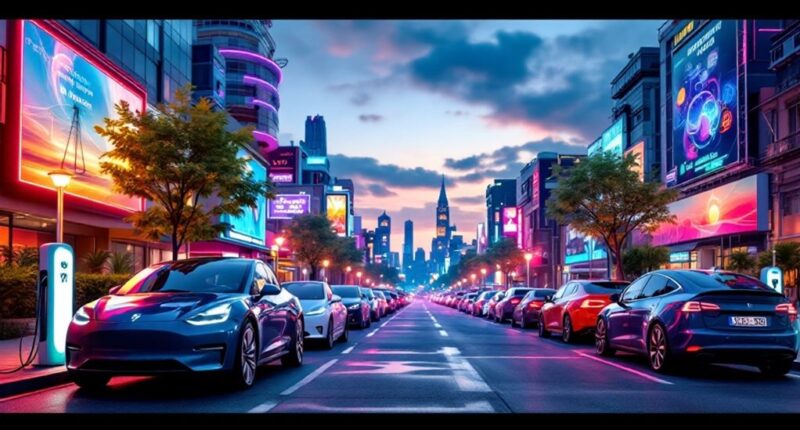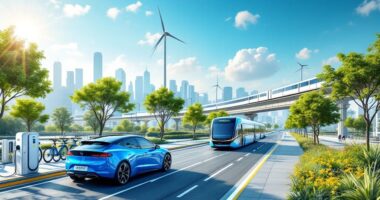The electric vehicle market is undergoing a thrilling transformation, with 14 million EVs sold in 2023 alone—a juicy 35% increase from 2022. Electric cars now make up 18% of all vehicle sales, with China and Europe leading the charge. With nearly 590 models available, including a tasty array of SUVs, competition is heating up. As battery technology evolves, including the promise of solid-state wonders, the future looks charged. Stay tuned for more exciting trends on the horizon!

Amidst the electric hum of progress, the global electric vehicle (EV) market is undergoing a remarkable transformation that feels almost like watching a high-speed chase in a blockbuster movie. In 2023, a thrilling 14 million EVs zipped off the lots, marking a staggering 35% increase from the previous year. By the end of the year, over 40 million electric cars were projected to be cruising the roads worldwide. Imagine, 18% of all cars sold this year were electric, a jump from 14% in 2022. It seems the future of driving is not only electric but also very much here.
The regional trends tell an enthralling story. In China, over a third of new car registrations were electric, while Europe followed closely with more than one-fifth. The United States, not wanting to be left out, managed to register one in ten new cars as electric. Meanwhile, Norway is in a league of its own, boasting a jaw-dropping 80% of new car sales as electric. If only Japan and India could catch up; their EV adoption rates are lagging behind the big players.
Diving into the meaty details, nearly 590 EV models are available globally, with SUVs and large vehicles making up two-thirds of the lineup. The battery technology is evolving faster than a superhero on a mission — costs have drastically dropped, and solid-state batteries promising longer ranges are in the works. Digital transformation is crucial for manufacturers striving to enhance their product-market fit. As EV sales exceeded 10 million units in 2022, the momentum for electric vehicles continues to gain traction worldwide.
With nearly 590 EV models available, the battery tech race is on, promising longer ranges and lower costs!
As EVs charge into the future, competition is heating up like a high-stakes race. Tesla and BYD dominate the field, controlling 35% of global sales. However, Chinese manufacturers are revving their engines, while traditional US automakers are feeling the pressure. With government policies pushing for ICE vehicle bans and expanding charging infrastructure, it’s clear: the electric revolution is not just a trend; it’s a movement. Buckle up; the ride is only getting started.
Frequently Asked Questions
What Are the Environmental Impacts of Electric Vehicle Production?
Electric vehicle production has its environmental quirks. While they promise a greener future, the reality is a bit murky.
Mining for materials like lithium and cobalt can wreak havoc on ecosystems and communities, with pollution and human rights issues coming into play.
Plus, the manufacturing process emits notably more CO2 than making conventional cars. It’s a paradox: the shiny new EVs might just be starting their journey with a hefty carbon footprint.
How Does Battery Recycling Work for Electric Vehicles?
Battery recycling for electric vehicles is a fascinating process that begins with collecting used batteries from various sources. They get sorted and partially disassembled, ensuring safety while preventing fiery mishaps.
Next, the batteries are shredded, creating a “black mass” of valuable materials. This is where hydrometallurgical recycling shines, recovering up to 99% of precious metals like nickel and cobalt. In contrast, pyrometallurgical methods are less favored due to their environmental impact, like a clunky old car in the fast lane.
What Incentives Are Available for Electric Vehicle Buyers?
Incentives for electric vehicle buyers are as plentiful as candy in a convenience store. Federal tax credits can reach up to $7,500 for new rides, while states like California might sweeten the deal with up to $14,000.
Some automakers join the fun with cash rebates and free charging perks. Plus, non-financial goodies like HOV lane access and special parking spots make driving an EV feel like a VIP experience.
Talk about a win-win
How Do Electric Vehicles Affect Power Grid Stability?
Electric vehicles (EVs) can shake up power grid stability like a surprise pop quiz. If unmanaged, they might double electricity demand, straining old infrastructure faster than a teenager’s phone battery.
Imagine the scenario: chargers firing up during peak hours, turning local transformers into overworked gym rats. However, smart charging solutions, like demand response programs, can help balance the load, letting the grid breathe easy while keeping those electric wheels rolling smoothly.
What Are the Safety Concerns Related to Electric Vehicle Batteries?
Safety concerns surrounding electric vehicle (EV) batteries can be quite the hot topic—literally From thermal runaway causing tough-to-extinguish fires to toxic fumes that could clear a room faster than a bad taco, the risks are real.
These fires can burn longer than a Netflix binge session, needing thousands of gallons to extinguish. However, EVs generally have a lower fire risk than traditional cars, thanks to ongoing safety improvements and better battery tech.









